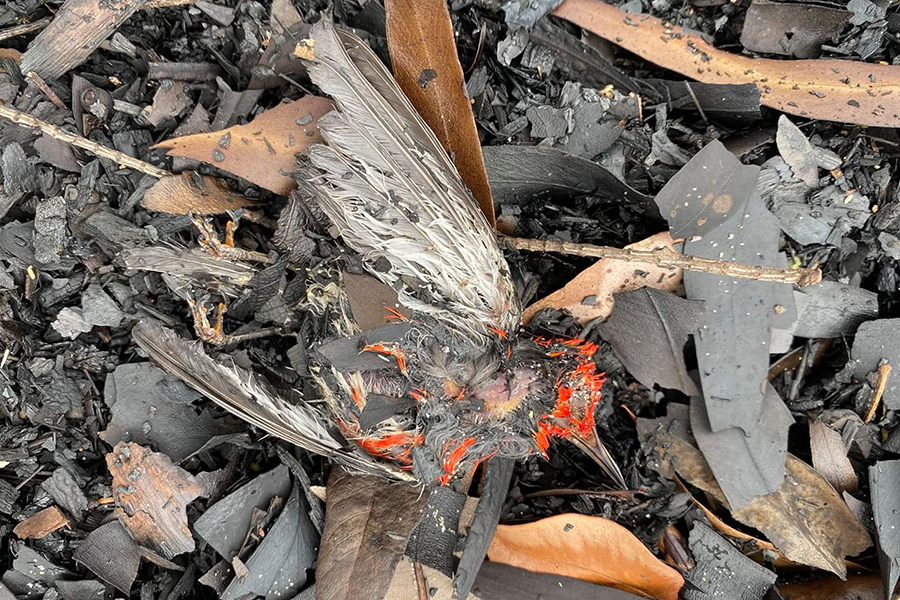
The political endorsement of extinction

Opinion by MERRILL WITT
Prime Minister Scott Morrison maintained a business-as-usual approach in response to last September’s School Strike 4 Climate rallies. Despite the protests attracting record-breaking crowds across the nation, Morrison complained that the student strikers were responsible for creating “needless anxiety” in children.
Needless anxiety is certainly not how you would describe the current mood of most Australians. Thousands of holidaying families spent New Year’s Eve huddled on town beaches along the NSW and Victorian coasts trying to escape massive bushfires raging nearby.
People have looked on in dismay as the PM continues to downplay climate change as a contributing factor to the prolonged drought and extended heatwaves, which experts believe have precipitated the current crisis.
Land clearance
Regrettably, if recent government policy decisions are any guide, the business-as-usual approach looks only set to continue.
On Boxing Day, Natural Disaster and Emergency Management Minister David Littleproud called for a new inquiry into land-clearing and controlled burn-offs. Much like the last one, this inquiry is partly in response to the Queensland Government’s strengthening of native vegetation land-clearing rules in 2018.
The new laws were designed to curb huge spikes in land clearing rates that occurred when the previous Liberal National Party Government relaxed tighter rules introduced in 2009 by the former Labor Government.
The Prime Minister’s own position on Queensland’s tougher stance on land-clearing is clear. “The Queensland state government is negligent when it comes to how they are handling these native vegetation laws,” he told Macquarie Radio on 6 December 2019.
Ironically, an overall reduction in the nation’s land-clearing rates has allowed Australia to meet its modest carbon emission reduction targets.
Professor Frank Jotzo, director of the Centre for Climate and Energy Policy at the ANU Crawford School of Public Policy, told the Guardian that Angus Taylor, the Minister for Energy and Emissions Reduction, could only claim that Australia’s emissions have dropped by 12.9% since 2005 because of changes in land use, mainly due to the reduction in overall land-clearing rates. “If these changes are removed, Australia’s 12.9% drop between 2005 and 2018 turns into a 6% rise,” he said.
So far, an estimated five million hectares and counting have been destroyed by the bushfires, so perhaps the government no longer needs to worry about the “risks” of too little land clearing? But the ongoing loss of native vegetation, coupled with the bushfire devastation of irreplaceable old-growth forests, are likely to exacerbate the effects of climate change.
Writing for the Conversation in 2016, University of Queensland researchers described how land-clearing makes parts of Australia warmer and drier because it reduces soil moisture. Retention of ground moisture is critical because it “reduces temperatures and contributes to cloud formation and increased rainfall. The increased rainfall then provides more moisture to soils and vegetation,” the researchers said.
The political endorsement of extinction
“The political endorsement of extinction” was a phrase coined by Rachel Walmsley, Policy & Law Reform Director EDO NSW, to describe the federal government’s accreditation of the NSW Government’s biodiversity offsets policy for major projects “despite concerns that it failed to meet national environmental standards.” Cash payments in NSW, for example, are now an acceptable alternative to sourcing an alternative habitat for a threatened national species impacted by a new mine site.
The lesser standards for biodiversity offsets are incorporated into the new Biodiversity Conservation Act 2017, a controversial suite of laws and regulations that are already detrimentally impacting biodiversity.
Recent figures released by the former Office of Environment and Heritage, for example, showed that in the first year of the new Act, land clearing for agriculture jumped to 27,100 hectares, triple the level in 2014-15. This alarming statistic triggered a still unpublished independent review of the legislation by the NSW Natural Resources Commission.
Unfortunately, the federal government seems unlikely to strengthen its own environmental protections. In October, the Environment Minister Sussan Ley said the goal of a yearlong review of the Environment Protection and Biodiversity Conservation (EPBC) Act is “tackle green tape and deliver greater certainty” to business, farmers and conservation groups.” Similar language was used to justify the NSW reforms.
In a Boxing Day interview with the ABC’s Kim Landers, Ley avoided directly answering a question about whether the review would lead to “stronger protections for native animals, not weaker ones,” despite confirming that at least 30 per cent of the koalas in the mid-north coast have perished in the recent bushfires because about a third of their habitat has been destroyed.
Ecologists from the University of Sydney now estimate that 500 million mammals, birds and reptiles have been lost since September, a staggering statistic that keeps rising by the day. How much more destruction will we be forced to witness before the government admits that its business-as-usual approach to our climate emergency is no longer working?









